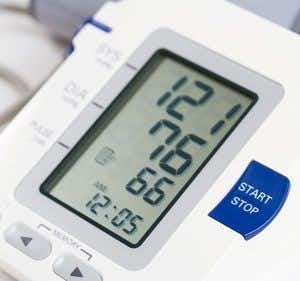
How low should your blood pressure go? Doctors have a surprisingly hard time answering this seemingly simple question.
Historical “High” Blood Pressure:
In the mid 20th century, doctors accepted as natural blood pressure readings that would terrify today’s physicians. A pre-eminent cardiologist, Charles Friedberg, MD, wrote in his popular textbook that mild benign hypertension, which he counted as blood pressure up to 210/100, did not require treatment (Journal of Clinical Hypertension, Suppl. 8, Aug., 2006).
The Middle Years and Hypertension:
By the 1960s and 1970s data from the Framingham Heart Study suggested that getting blood pressure down from such high levels could save patients from suffering kidney damage, congestive heart failure and stroke. Doctors also had more and better blood pressure medications to prescribe, and thus began the downward drift of standards for where blood pressure “should” be.
Guidelines for Treating High Blood Pressure:
The first guideline was published by the Joint National Committee on Prevention, Detection, Evaluation, and Treatment of High Blood Pressure in 1977. It recommended treatment if diastolic blood pressure (the second and lower number) went to 105.
The Idea of Prehypertension Takes Root:
By 2003, the official guideline was that hypertension started at a blood pressure of 140/90. Blood pressure over 120/80 was considered prehypertension. Soon, many doctors started prescribing pills for people diagnosed with prehypertension. Even some older people with no signs of heart disease or organ damage from high blood pressure were placed on medications if their systolic readings were over 120.
Hypertension Heresy: Are We Overtreating High Blood Pressure?
In 2012 the Cochrane Collaboration published a meta-analysis of randomized controlled trials of blood pressure treatment (Cochrane, Aug. 15, 2012).
After reviewing the evidence, these experts concluded that the majority of Americans diagnosed with hypertension (roughly 70 million people) might be treated unnecessarily. The analysts assessed data from four randomized controlled trials (RCTs) involving 9,000 patients with stage 1 hypertension. Their conclusions:
“Antihypertensive drugs used in the treatment of adults (primary prevention) with mild hypertension (systolic BP 140-159 mmHg and/or diastolic BP 90-99 mmHg) have not been shown to reduce mortality or morbidity in RCTs. Treatment caused 9% of patients to discontinue treatment due to adverse effects. More RCTs are needed in this prevalent population to know whether the benefits of treatment exceed the harms…
“Available data from the limited number of available trials and participants showed no difference between treated and untreated individuals in heart attack, stroke, and death.”
The Latest Flip-Flop on Treatment of Hypertension:
In 2015, a large study of blood pressure treatment was stopped prematurely with much hoopla because the results were so good (New England Journal of Medicine, Nov. 26, 2015).
The SPRINT study (Systolic Blood PRessure Intervention Trial) found that getting systolic blood pressure down to 120 or lower reduced the risk of a heart attack compared to getting blood pressure below 140.
The investigators recruited 9,361 people with hypertension (defined as systolic BP of 130 or higher) and increased cardiovascular risks such as heart disease, kidney disease or other factors that would predispose them to heart attacks or strokes. Subjects who had their blood pressure reduced to 120 or below were 25 percent less likely to experience a heart attack or other cardiovascular event compared to those who only got their systolic BP under 140.
That 25 percent reduction is known as relative risk. In terms of absolute risk reduction, 1.65 percent of those getting BP under 120 (intensive treatment) had a vascular event compared to 2.19 percent in the standard treatment group.
Another way to understand the results:
How many people had to be treated to save a life? According to the investigators, 172 people needed to be treated intensively for three years to prevent one death from cardiovascular causes. In other words, a lot of people were treated aggresively for hypertension without experiencing life-saving benefits.
What About Drug Side Effects?
Over a third of the subjects in the SPRINT study experience serious adverse events (defined as fatal or life-threatening). They included excessively low blood pressure, fainting or loss of consciousness, falls, electrolyte abnormalities, kidney injury or kidney failure. Roughly half of the people over 75 experienced life-threatening or fatal adverse drug events. Falls that led to a trip to the emergency department or hospitalization were not uncommon.
Take Home Message:
What should we make of this hypertension confusion? There is no doubt that lower blood pressure is better than higher blood pressure, but how that’s achieved may make a difference in people’s quality of life. Blood pressure medicine can cause side effects including dizziness, fatigue, forgetfulness, impotence, cough or swollen legs not to mention kidney damage and life-threatening falls.
Lowering blood pressure through diet, exercise and weight loss offers a safer alternative for many people. Our Guide to Blood Pressure Treatment describes the DASH diet that has been scientifically tested and shown to lower blood pressure, along with other nondrug approaches. Anyone who would like a copy, please send $3 in check or money order with a long (no. 10) stamped (71 cents), self-addressed envelope: Graedons’ People’s Pharmacy, No. B-67, P. O. Box 52027, Durham, NC 27717-2027. It can also be downloaded for $2 from this website:.
Certain foods such as beets, chocolate, Concord grape juice, kefir and pomegranate also hold promise for blood pressure control without the side effects that blood pressure medications may cause. You will find a a great deal of additional information about alternative treatments for hypertension in our book, Best Choices from The People’s Pharmacy.
Please share your own perspective on blood pressure treatment below in the comment section and vote on this article at the top of the page.

